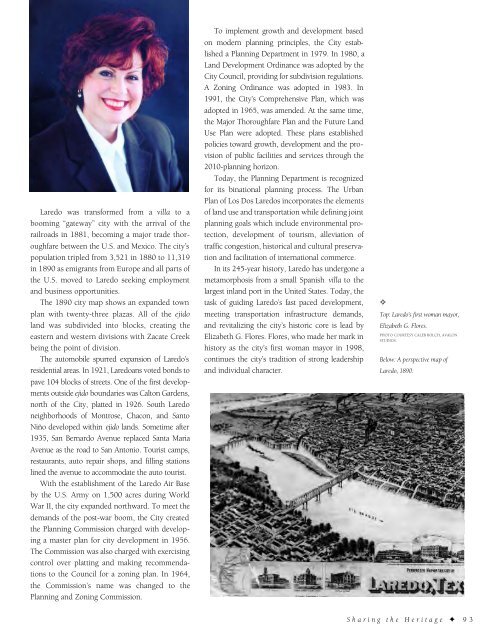Historic Laredo
An illustrated history of the city of Laredo and the Webb County area, paired with the histories of companies, families and organizations that make the region great.
An illustrated history of the city of Laredo and the Webb County area, paired with the histories of companies, families and organizations that make the region great.
Create successful ePaper yourself
Turn your PDF publications into a flip-book with our unique Google optimized e-Paper software.
<strong>Laredo</strong> was transformed from a villa to a<br />
booming “gateway” city with the arrival of the<br />
railroads in 1881, becoming a major trade thoroughfare<br />
between the U.S. and Mexico. The city’s<br />
population tripled from 3,521 in 1880 to 11,319<br />
in 1890 as emigrants from Europe and all parts of<br />
the U.S. moved to <strong>Laredo</strong> seeking employment<br />
and business opportunities.<br />
The 1890 city map shows an expanded town<br />
plan with twenty-three plazas. All of the ejido<br />
land was subdivided into blocks, creating the<br />
eastern and western divisions with Zacate Creek<br />
being the point of division.<br />
The automobile spurred expansion of <strong>Laredo</strong>’s<br />
residential areas. In 1921, <strong>Laredo</strong>ans voted bonds to<br />
pave 104 blocks of streets. One of the first developments<br />
outside ejido boundaries was Calton Gardens,<br />
north of the City, platted in 1926. South <strong>Laredo</strong><br />
neighborhoods of Montrose, Chacon, and Santo<br />
Niño developed within ejido lands. Sometime after<br />
1935, San Bernardo Avenue replaced Santa Maria<br />
Avenue as the road to San Antonio. Tourist camps,<br />
restaurants, auto repair shops, and filling stations<br />
lined the avenue to accommodate the auto tourist.<br />
With the establishment of the <strong>Laredo</strong> Air Base<br />
by the U.S. Army on 1,500 acres during World<br />
War II, the city expanded northward. To meet the<br />
demands of the post-war boom, the City created<br />
the Planning Commission charged with developing<br />
a master plan for city development in 1956.<br />
The Commission was also charged with exercising<br />
control over platting and making recommendations<br />
to the Council for a zoning plan. In 1964,<br />
the Commission’s name was changed to the<br />
Planning and Zoning Commission.<br />
To implement growth and development based<br />
on modern planning principles, the City established<br />
a Planning Department in 1979. In 1980, a<br />
Land Development Ordinance was adopted by the<br />
City Council, providing for subdivision regulations.<br />
A Zoning Ordinance was adopted in 1983. In<br />
1991, the City’s Comprehensive Plan, which was<br />
adopted in 1965, was amended. At the same time,<br />
the Major Thoroughfare Plan and the Future Land<br />
Use Plan were adopted. These plans established<br />
policies toward growth, development and the provision<br />
of public facilities and services through the<br />
2010-planning horizon.<br />
Today, the Planning Department is recognized<br />
for its binational planning process. The Urban<br />
Plan of Los Dos <strong>Laredo</strong>s incorporates the elements<br />
of land use and transportation while defining joint<br />
planning goals which include environmental protection,<br />
development of tourism, alleviation of<br />
traffic congestion, historical and cultural preservation<br />
and facilitation of international commerce.<br />
In its 245-year history, <strong>Laredo</strong> has undergone a<br />
metamorphosis from a small Spanish villa to the<br />
largest inland port in the United States. Today, the<br />
task of guiding <strong>Laredo</strong>’s fast paced development,<br />
meeting transportation infrastructure demands,<br />
and revitalizing the city’s historic core is lead by<br />
Elizabeth G. Flores. Flores, who made her mark in<br />
history as the city’s first woman mayor in 1998,<br />
continues the city’s tradition of strong leadership<br />
and individual character.<br />
✧<br />
Top: <strong>Laredo</strong>’s first woman mayor,<br />
Elizabeth G. Flores.<br />
PHOTO COURTESY CALEB BOLCH, AVALON<br />
STUDIOS.<br />
Below: A perspective map of<br />
<strong>Laredo</strong>, 1890.<br />
Sharing the Heritage ✦ 93
















